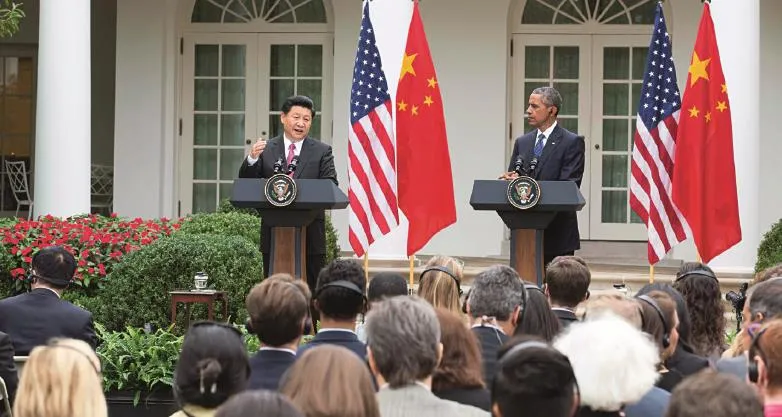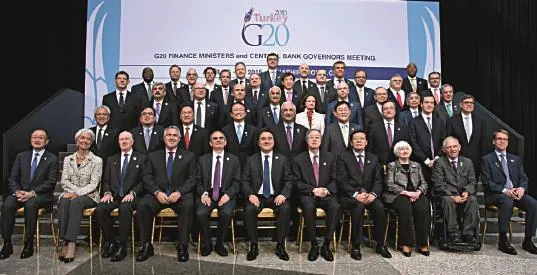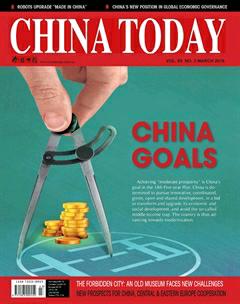China’s Major-Country Diplomacy Progresses on All Fronts
2016-09-14ByHEYAFEI
By HE YAFEI
China’s Major-Country Diplomacy Progresses on All Fronts
By HE YAFEI
REPLETE with its own unique features, China’s major-country diplomacy has made comprehensive progress in recent years. Upholding a new model of international relations centered on win-win cooperation, China has actively built up a global partnership network. It has expanded its relations with other major countries, forged closer ties and deepened its collaboration with other developing countries, and become ever more involved in global governance even as it broadens its scope. It has also promoted reforms to governance mechanisms and systems by contributing China’s views and plans thereto. Chinese-style major-country diplomacy has thus delivered remarkable results over past years.
Extended Global Partnership
China’s foreign policy of establishing open and inclusive global partnerships based on win-win cooperation is welcomed by other countries. China’s partners are now to be found everywhere in the world. An innovation of China’s independent foreign policy of peace, the global partnership network transcends the simplistic “non-aligned”or the U.S.-led “military alliance” models of inter-country relations. With the core concepts of “respect for justice,”“adherence to principles,” and “striving for win-win results,” this partnership embodies China’s millenniaold philosophical ideals and core values. They include searching for common ground while reserving differences, harmony in diversity, and the vision of harmony and peaceful co-existence. It is therefore both viable and appealing.
China deplores the mindset and rules of the zero-sum game, and deprecates any exclusive alliance. Rather, it upholds an open and inclusive world order that supports diversity and reciprocal learning and an international relationship that allows for peaceful coexistence, equality and win-win cooperation. A manifestation of China’s global partnership concept is its diplomacy toward its neighbors. It features amity, sincerity, mutual benefit and inclusiveness: thus far, China has established various forms of strategic partnership with 67 countries and five international organizations, signifying that its view of global partnership finds endorsement and support worldwide.
Chinese President Xi Jinping has elevated the ideal of global partnership to new levels with his proposal to jointly build a community of shared future with international society. The global partnership network China advocates is inherently different from the U.S.-led military alliance spawned in the Cold War period, which is closed, exclusive, and whose primary aim is confrontation, even military confrontation. The relationship between the U.S. and its allies rests not on an equal footing, but is rather U.S.-centric. Its allies depend on the U.S. to varying degrees for their security.
In contrast, the network of global partnership China anticipates, with or without the “strategic” prefix, is open and inclusive, and targets win-win cooperation. Not intended to counter a third country, it comports with the“Bandung spirit” and the Five Principles of Peaceful Coexistence, and serves the goal of world peace and stability and common economic development.
The partnership China proposes is not discriminatory or divisive. It sets up no “us” and “them” camps, as it aims to achieve cosmopolitism and build a community of shared future, which both demands and facilitates collaboration.
This global partnership network is moreover not Chinadominated. It is a set of multi-centric, multi-layered and multi-pivotal sub-networks of regional and international cooperation that are interconnected and interwoven. It covers interstate cooperation in the southern hemisphere, and that between the northern and southern hemispheres, as well as those defying such geographical pigeonholes. Given the rich diversity of the world and the disparity in the development levels and models of different nations, this global partnership network pioneers a new relationship paradigm in which countries learn from, unite and cooperate with one other in the Internet Plus era, yielding a “one plus one equals more than two” effect.
Full Participation in Global Governance
Global governance concerns the international order and rules, and thus serves as the yardstick and framework for countries in dealing with international affairs. China, the world’s second largest economy, a permanent member of the UN Security Council, and a key member of the G20, is an important participant in, constructor of and contributor to global governance, as well as a central motive force in the reform of global governance. China is intensively involved in global governance, and leavens governance concepts and mechanisms by offering its thoughts and plans in this regard. These endeavors will exert a significant influence on the formation of a newglobal order in the 21st century.

On September 25 local time, 2015, President Xi Jinping and President Barack Obama jointly meet with the press after their talks in Washington D.C.
President Xi has pointed out that, following the increase of global challenges, strengthening global governance and advancing reforms to the global governance system is a historical trend. We should promote innovative evolution of the global governance concept, and adopt from Chinese culture those approaches to and notions of governance that mesh with current reality. Furthermore, we should establish the concept of a community of shared future for all humankind by promoting the global governance conception of mutual consultation, joint development and shared benefits.
Since the advent of the new century, the fundamental changes besetting global governance have shaped the agenda for reforms. These changes have occurred in three areas:
First, the global financial crisis that erupted in 2008 buffeted the neo-liberalism and Washington consensus trumpeted by the U.S. and exacted a heavy toll on both the hard and soft power projected by Western countries. Its recovery stalling, the world economy has yet to reattain its pre-crisis levels. In this situation, all countries are exploring new conceptions of and mechanisms for global governance. Das Kapital by Karl Marx and Capital in the Twenty-First Century by Thomas Piketty, published about one and a half centuries apart, both expose the greed of capitalism and the advantages favoring capital over labor in profit-sharing.
Second, the rise of developing countries has narrowed the strength gap between East and West, catalyzing the steady transition from Western dominance to West-East co-governance. Yet the voices of developing countries in the global governance system still lag behind their strength.
Third, China’s proactive involvement in the global governance system has produced remarkable results. Continuing strong growth in China is the sole bright spot in an otherwise languishing world economy and contributes more than 30 percent to annual world growth. China’s unselfish, outstanding performance within the G20 in response to the financial crisis has been commended by other countries around the world. Its advantage in the state system, development path and development mode have consequently aroused great attention from the rest of the world and won wide recognition.
With its extensive and intensive participation in global governance, China is taking concrete measures to promote common development and a stronger recovery and sustainable growth of the world economy. The most salient example of this is the Belt and Road Initiative propounded by President Xi Jinping. This marks an innovation in the cooperation pattern in global governance, and offers new inspiration for regional and even trans-regional economic integration. Welcomed by 60-plus countries to date, the initiative taps a great opportunity for common development in the new century for the many countries lining the Belt (the Silk Road Economic Belt) and the Road (the 21st-century Maritime Silk Road).
China is now in discussions with other countries along the two routes about communicating over their policies and aligning their development strategies. This will prepare the ground for infrastructure connectivity, tradeintegration, capital flow and friendly exchanges, and reciprocal learning. New international financial institutions such as the Asian Infrastructure Investment Bank (AIIB) and the Silk Road Fund will infuse great momentum into the construction of the Belt and Road.

G20 Finance Ministers and Central Bank Governors Meeting held on February 9-10, 2015, in Istanbul, Turkey.
Though the intention of the U.S.-spearheaded Trans-Pacific Partnership (TPP) is to sideline China in the formulation of new global governance rules, China takes an open attitude, nonetheless, towards such schemes for regional integration. The country is now the largest trade partner of 128 economies worldwide, and the largest manufacturer globally. On the basis of the experience garnered from the four domestic free-trade zones, China has adopted a new pattern of opening-up to both developed and developing countries, with the emphasis on mutual opening up with developing countries along the Belt and Road. This dual-opening strategy gives wings to China’s economic restructuring, and global economic growth as well.
The reform of global governance – nowhere close to completion – will profoundly influence the fine-tuning and reshaping of the international order and the rules for the new century. The world is closely watching the instrumental function China discharges as a core member of the G20 and president of the 2016 G20 Summit. This attention and its corresponding expectations offer a good opportunity for the PRC’s Chinese-style major-country diplomacy to serve as a pivot in the reform of global governance.
Manifest Results
Under the guidance of Chinese-style major-country diplomacy, China’s relationship with the U.S. has made headway amid conflicts, its ties with European countries have transitioned to new phases, and its friendly cooperation with other BRICS states and developing peers has deepened. These accomplishments have erected a framework for a new major-country relationship paradigm, transcended geopolitical boundaries, and in turn consolidated the foundation of Chinese-style majorcountry diplomacy.
Coinciding with an increasingly complicated international situation, faltering recovery of the world economy, and recurring conflicts between the two countries, President Xi’s state visit to the U.S. last September is of signal historical and practical significance. Despite their opposition on the South China Sea issue and the growing uncertainties and complexities in Sino-U.S. relations during the U.S. presidential election campaign, the two countries have maintained smooth communications and hewed to the consensus of building a new model of majorcountry relations.
This consensus comprises three elements: First, both parties are convinced that an incumbent power and an emerging power do not inevitably slip into the “Thucydides’ trap.” China steadfastly pursues the path of peaceful development and winwin cooperation on the basis of defending its sovereignty, security and development interests. The U.S. has hailed a stronger and more developed China, with which it has expressed the wish to engage in constructive competition and cooperation.
Second, China and the U.S. have reached a basic consensus on the international order and reform of global governance; this has assuaged U.S. concerns over China challenging the existing international order. Rivalry in the crafting of regimes and rules of international relations lies at the core of interstate competition and is the epicenter of tensions between China and the U.S. As the system of international order and global governance implicate the sovereignty interests of every country, the handling of this issue decides whether China and the U.S. may achieve peaceful coexistence and win-win cooperation. China’s invaluable contributions to staving off a world economic meltdown through its close cooperation with other G20 members stand as an admonition to both China and the U.S. that, by virtue of their respective international clouts, cooperation between them is in the interest of not only both sides, but also of overall global development and stability.
Third, China and the U.S. have displayed to one another sincerity and candor, not downplaying disagreements or conflicts, but instead increasing management and control of exigencies and crises. They have established communication mechanisms between their militaries, and opened channels for coordination on cyber-security. These factors all attest to the maturing relationship between them, and their capacity to manage and control discord and avert confrontations and clashes.
China has meanwhile also strengthened its ties with other major nations, including the U.K., France, Germany, and Australia. This stands as another indicator of the progress of its Chinese-style diplomacy on all fronts. China’s intention of building a global partnership network squares with these countries’ desires to institutepragmatic cooperation with China and board its train of development.
This is evident in the successful visit by the Chinese president to the U.K. last October. The deals struck during this visit, covering in-depth bilateral cooperation in the fields of nuclear power, high-speed rail, and finance, break new ground for production capacity cooperation between China and developed Western countries. With the demise of the dichotomy hitherto bifurcating international relations – often demarcated along the lines between the West and East and northern and southern hemispheres – a global partnership based on shared interests now enjoys wide currency. China’s thinking on common development and win-win cooperation, therefore, is gaining popularity.
Mid-sized Western powers like the U.K., France, Germany, Australia, and Italy reserve many differences with the U.S. over their foreign strategies. In the manner of major developing countries such as Brazil, India, Turkey and Indonesia, they advocate a multi-polar world and democratic international relations. These countries saw in the 2008 financial crisis and the ensuing economic and debt crisis the pressing need to reform the global governance system – including its monetary system –to reduce systemic risks. They espouse many of China’s ideas on global governance, and are willing to coordinate efforts with it to improve the global governance system in a way that reflects the changes occurring in the international tableau.
Given the growing influence of mid-sized powers in international affairs, China should accord due attention to them in the construction of the global partnership network, as they serve an indispensable function in regional and international affairs. These countries include both Western and other developed countries – the U.K., France, Germany, South Korea, Canada, Italy, Spain and Australia – and developing countries – Mexico, Turkey, Iran, Indonesia, South Africa, Argentina, Egypt and Saudi Arabia.
The mid-sized powers share the trait of pursuing relatively independent foreign policies in varied areas of international relations that allow them room for maneuver. With their respective distinct features, these countries constitute the “middle class” and “upper-middle class” of the international community, the force driving transformation of the international power structure in a planar direction. For instance, the Uniting for Consensus movement, spearheaded by South Korea, Mexico, Pakistan and Argentina, has proven a strong counterweight to attempts by Japan, Germany, India and Brazil to gain permanent seats on the UN Security Council in a collective deal.
All developing countries whatsoever will remain the bedrock and strategic focus of China’s major-country diplomacy with its own indigenous characteristics. China remains keenly aware of its identity as a member of the developing world.
As President Xi reiterated at the activities marking the 70th anniversary of the UN, the country’s vote at the organization will always go to developing countries. The memory will never fade of how its developing peers“hoisted” China into the UN by voting for Resolution 2758 in 1971, which recognized the People’s Republic of China as the only legitimate representative of China to the United Nations. This bond between China and other developing countries, as inseverable as that between flesh and blood, is the foundation of China’s major-country diplomacy with its own characteristics.
As the gap between developed and developing countries narrows, dual shifts are underway in the world economic growth pattern. One is a steady increase in the contributions by developing countries, including China (whose share has topped 30 percent for successive years), to world economic growth, which is causing its center of gravity to migrate from the developed to the developing world. The other is closer economic ties between China and other developing countries – as reflected in the new emphasis in China’s foreign trade from developed to developing countries.
At the start of the 21st century developed and developing countries respectively contributed 80 percent and 20 percent to global GDP growth. By the 2010-13 period, these figures had reversed, at 19 percent and 81 percent, and China’s share was the largest, at about 35 percent.
Export statistics for recent years reveal that developing countries are now China’s trade partners with the highest growth rates and greatest potential. In the 2013-14 period, China’s export growth dipped to 7.2 percent, while that to G7 countries dropped to 4.4 percent, to other developed countries to 7.4 percent, and to other BRICS countries to 6.1 percent. By contrast, growth with other developing countries remained robust – 12 percent, with ASEAN states topping the chart at 16 percent.
As regards China’s export proportions, at 2000 G7, other developed countries, BRICS and other developing countries, accounted for 48 percent, 35.2 percent, 2.7 percent and 13.9 percent respectively. By 2014 these figures had shifted to 3.9 percent, 30.8 percent, 6.2 percent and 29.2 percent, signifying a 19 percent upsurge for developing countries.
China’s foreign policy must evolve in lockstep with the times. It must therefore attend more to its partnerships with other developing countries. This is China’s motive for advancing the Belt and Road Initiative. Also for shifting the focus of the country’s opening-up from prioritizing developed countries to giving equal attention to developed and developing countries, wherein littoral developing countries receive preferential treatment. This move chimes with the vision of Deng Xiaoping – celebrated as the chief architect of China’s reform and openingup – of a comprehensive opening-up to different types of countries.
China is developing, as is the world as a whole, and this is triggering historical changes in their relations.C
HE YAFEI is deputy head of the Overseas Chinese Affairs Office of the State Council and a former deputy minister of foreign affairs.
